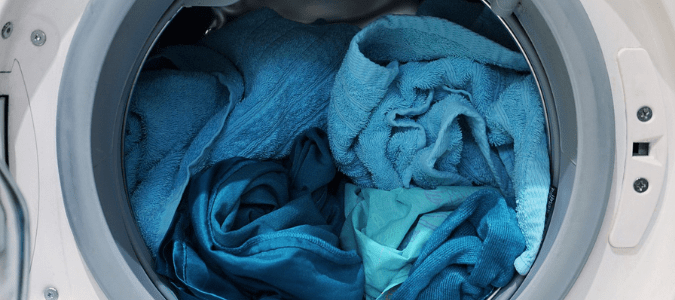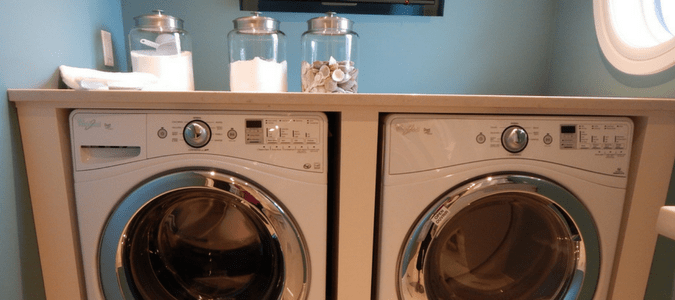It’s never a good thing to find water on the floor around your washing machine. Whether it’s a puddle or a rushing flood of water, you’re facing the risk of expensive water damage. Plus you know that something is broken in one of the most necessary appliances in your home.
The average American household washes up to 400 loads of laundry every year. That’s more than a load a day! With this heavy usage, it’s no surprise that the occasional mechanical problem arises. The loss of a washing machine, even for a few days, can be a huge inconvenience.
A washing machine houses an intricate system of valves, hoses and belts that allow it to fill and drain the water necessary for the washing process that cleans our clothes. When one or more parts of that system stop functioning correctly, gravity takes over. Then all that pressurized water, up to 500 gallons per hour, floods onto the floor and surrounding room.
This can lead to massive amounts of water damage and costly and time-consuming clean-up and repairs.
Washing machine malfunctions often require trained professionals to diagnose and repair leak issues. There are still a few things a homeowner can try themselves.
There are a limited number of places where the typical washing machine can leak water. Usually, it’s from the water pump, the tub or a hose or valve.
Loose Water Hoses or Valves
This is probably the most common reason for a leak, and the first place the homeowner should check for a leak if they’re finding water on the floor. The main hoses run from the machine’s interior out the back to the hot and cold water faucets from the wall. Often these faucets have red or blue handles.
This is the simplest place to check for a leak, as standing or dripping water will be present at the connection and likely running down the wall itself. If you suspect that you have a leak, your first step should be to unplug the washer from the power plugs. Then turn off both faucets to prevent any further loss of water.
If the faucets or handles are wet, they may have come loose from the hoses due to the vibrations that the washing machine makes while washing. Check that each hose connection has a good rubber gasket and is firmly screwed into the faucet.
Dry the area around the connection thoroughly, and then turn the water back on to see if it still leaks. If not, plug the power back in, and you’re good to go!
Clogged or Loose Drain Hose
If your washing machine is still leaking water, the next thing to check is the drain hose. This hose moves the used water from the tub and into your home’s outgoing water or sewage system.
This is a large, heavy rubber hose or pipe with a steep bend at the end of it. It often rests in an outflow pipe on or inside the laundry area wall. If this hose has a cut or damage, it can leak. If there’s a blockage somewhere in your home’s outgoing water pipes, water can back up and overflow.
Check both the drain hose and drain pipe for signs of moisture or standing water in the pipe itself.
Internal Water Hose Damage
If those first two steps don’t seem to fix the issue, you may need to remove the metal housing from the machine. You’ll then need to inspect the internal pipes for damage or a loose connection.
Before doing so, check any manufacturer’s warranties or guarantees to ensure they aren’t voided by removing internal or external parts of the washing machine before attempting this work yourself.
With the housing out of the way, you’ll see two hoses lead from inlet valves and connect to the washing machine tub. Check both hoses for cracks, holes or signs of leaking, as well as the connections at the tub.
If there are signs of leakage or damage and the general area is wet, but you can’t find the exact spot of the leak, dry these hoses and connections. Then, plug the power and water back in. Finally, run a wash cycle to see if you can see the exact place that water is leaking from in these areas.
Be sure to check the outflow hose and its tub connection as well.
Broken or Disconnected Drain Pump
Once you’ve ruled out the possibility of hose and connection leaks, it’s time to look at the drain pump to determine if it’s disconnected or damaged.
The drain pump pulls the used water out of the tub and forces it into the outlet hose and the wastewater drain. The pump’s seal or connection can work its way loose over time because of the constant vibrations of the machine.
Again, check the connection for a good gasket, and then make sure it’s sufficiently tightened.
A broken drain pump, if there is a damaged casing, will leak water every time it attempts to drain the washing machine.
Faulty Door Catch
One issue often overlooked when determining the cause of leaking water from a washing machine is the washing machine door itself.
If the door becomes bent or the gasket surrounding it becomes cracked or damaged, water that hits the inside of the door during the wash cycle can find its way out of these gaps and onto your floor.
Although this happens most often with front-loading washing machines, it can occur in top-loaders as well.
How Can I Fix a Leaking Washing Machine?
Again, before you attempt any repairs, ensure the washing machine has been physically unplugged and disconnected from power.
If the leak appears to be coming from the front of the washing machine, it’s usually from an overflowing tub. This is most often caused by a restriction in the outflow pipe or a bad water pump (ie: old water isn’t draining before freshwater flows in.)
If water appears to be coming from the underside of the machine, it’s most often a leak related to the water pump or its connections.
Removing or replacing the pump can be a complicated process requiring both plumbing and electric expertise. This is often a job best left to a licensed professional.
If water leaks from the rear of the machine (the side facing the wall), it’s likely an unsecured or damaged hose or a loose connection. Check all gaskets for leaks and tighten all visible hose connections.
Water at the back of the machine can also result from the outflow system backing up and overflowing. A damaged outflow hose is fairly simple to replace. Issues with your home’s grey-water and sewage systems can be major. An appliance repair professional should handle these issues.
What Do I Do if My Dryer is Leaking Water
Your washer isn’t the only machine that can create a puddle. A clothes dryer can collect condensation that leaks onto the floor as well.
Just like a glass of iced tea on a hot summer day, when the hot air from a dryer hits a cold surface, it creates condensation,
A dryer that’s kept in a cold environment or lacks proper insulation can create excess condensation as it heats up. Condensation can also collect die to a blocked exhaust system, vent pipe or a damaged flapper.
Depending on the configuration of your venting system, cleaning may require special tools to reach a blockage. This typically requires access from the roof.
A broken or damaged flapper can trap condensation if it’s closed or allow rain or snow to enter your dryer if it’s open. The latter can lead to serious damage to the mechanical and electrical components of your dryer.
How to Clean a Smelly Washing Machine
Let’s face it, a smelly washing machine equals smelly laundry. Nobody wants that. Standing water, mildew, dirty clothing and mineral build-up from water can all contribute to an odiferous washing machine.
The good news is that with just a few common household ingredients, you can banish the stink from your washing machine.
Here’s how:
- ¼ cup of baking soda and ¼ cup of water. Mix and pour into your washer’s detergent dispenser.
If that doesn’t do the trick:
- Add 2 cups of plain white vinegar to the washing tub and run a hot-wash cycle while the tub is empty.
- When done, scrub the inside of the tub with a 50/50 mix of water and vinegar solution to remove any remaining residue. Be sure to wash the door seal as well.
- Leave the washing machine door or lid open and let the inside air dry.
If you’ve tried these simple solutions and you’re still experiencing leaks, it’s likely the sign of a more serious issue.
A damaged tub or worn-out bearings can cause issues that can create leaks. Unfortunately, dealing with these repairs and replacements usually requires specialized tools and expertise that the average homeowner doesn’t have.
Serious repairs or diagnostics requiring major disassembly are best left to an appliance repair professional, as it will save you frustration, time and expenses in the long run. They can also help tell why your dryer might be smelling off.
ABC Can Get Your Washer Running and Keep Clothes Fresh
We rely heavily on our washing machines to get our clothes nice and clean. When something goes wrong, whether it be a clog, a bad smell or a leak, it can cause a huge disruption to your life. When you contact ABC Home & Commercial Services for appliance repair, we will send a specialist out to come make things right. Our professionals are licensed and highly-trained, so you can rely on them for a variety of services including repairs, installations and maintenance, as well as for overall advice on any appliance-related questions you may have.



